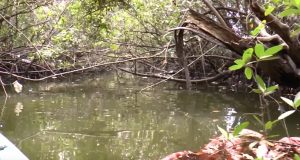We are in a two-person kayak in a shallow section of Salt Creek. Mangroves surround us, stretching out two and three feet from the bank to scrape the sides of our raft. The roots are filled with litter and discarded items that tell a story of the creek’s community: an extra-large Styrofoam Polar Pop cup, McDonald’s bags, a used condom, a torn plaid shirt, a soccer ball. The north bank leads to a parking lot for Family Dollar and McDonald’s; the southern bank, an empty lot. The branches reach across our path, making it impossible for us to continue. At this point, Salt Creek is hardly wide enough for us to turn around, and we leave the area with twigs and trash trailing behind.
On our return, we approach the Fourth Street Bridge. The falling Clearance! sign on the Family Dollar is sun bleached. The McDonalds drive-thru is full. A jagged and rusted pipe hangs in our path, right at eye level, and I tell my partner we will need to come to a stop to maneuver around the thing. I put my hand on the cool cement to stop our forward momentum, and I notice old credit cards stuffed between the pipe and the bridge: silver, red, and blue. To our right there is a man. White tee, jean shorts, clean white socks and sneakers. Two hands full of cash. My partner, aware of the necessity to return our rental on time to avoid a fee, asks the man “excuse me, sir, do you have the time?” With a casual roll of the wrist, the man tells us “2:40” and goes right back to counting. She apologizes for interrupting with a high pitched “Thank you!” I’ve pointed our kayak away from the broken pipe and I’ve wedged the oar into the creek bottom to propel the boat forward. I push off and we both begin to paddle a little faster.
Back in the wild corridor between the Third and Fourth Street bridges, a white egret crosses our path and I take a deep breath, laughing off my nerves. I feel at peace in this natural space, and I think again about the bridge and the man. Salt Creek subverts the street grid that was designed to create separate socio-economic spaces. The bridge is literally a liminal space, a transitional tool that occupies both boundaries, which makes a place that is susceptible to appropriation. A bridge becomes a place of secret action.
Like me, the man was using nature as a means of escape. I was using my time on the creek to forget about responsibility. In a way, the man was doing the same thing. He saw an opportunity to create a space that was separate from the one created for him, and he took action. He appropriated the space to participate in an economic society outside of the one that seems rigged against him. Nature in the city allows us this opportunity: to relax, replenish, and resist.
